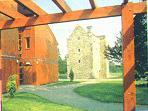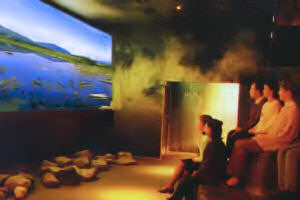Here is a useful list of interpretative centres in Ireland - such centres are so useful for the tourist for finding out much more about the attraction that they are visiting.
The Old Midleton Distillery
The Jameson Heritage Centre comprises 4.45 hectares (eleven acres) of grounds and is both architecturally and historically unique. The major buildings - Mills, Maltings, Corn Stores, Stillhouses, Warehouses and Kilns have been refurbished to their original splendour.
The Jameson Heritage Centre, with its craft shop and restaurant, is located on the main Cork-Waterford road just 12 miles East of Cork City.
The waterwheel which provided motive power for the operation is also still in place and in perfect working order. Of the many artifacts still remaining, pride of place goes to the largest Pot Still in the world which has a capacity of more than 30,000 gallons.
A tour of the Jameson Heritage Centre is a journey through the story of Irish whiskey by means of an audio-visual presentation (available in 6 languages).
Follow the old distillery trail through mills, maltings, corn stores, stillhouses, warehouses and kilns.
View the largest pot still in the world prior to sampling the internationally renowned Jameson Whiskey in the bar - perhaps have the opportunity of becoming a qualified Irish whiskey taster with presentation of certificate. Souvenir, Craft Shops and Elegant Restaurant on site.
Phoenix Park Visitor Centre 
The main entrance to the park is on Parkgate Street in Dublin 7. The Phoenix Park is made up of extensive lawns, tree-lined pathways, nature trails, lakes as well as ornamental gardens. Admission to the park is free and you’ll also get the chance to see a deer or two as it’s home to a herd of wild deer.
Attractions within the park include Dublin Zoo, the Phoenix Park Visitor Centre, the Wellington Monument, the Papal Cross, which was erected in memory of Pope John Paul II’s visit in 1979 and Áras an Uachtaráin, the home of the Irish president.
The centre is located in Europe’s largest urban park, a short distance from the Phoenix Monument.
Connemara National Park
Covering some 2,957 hectares of scenic mountains, expanses of bogs, heaths, grasslands and woodlands, Connemara National Park is a sight to behold. It’s located near Letterfrack in County Galway.
Within the park itself there’s a wide variety of wildlife. Birds such as skylarks, chaffinches, robins and wrens are just some of the common songbirds within the park. Birds of prey that are sometimes seen include the kestrel and sparrow hawk.
Rabbits, foxes, stoats, shrews, and bats are often observed at night. The largest mammal in the park is the Connemara Pony. Although a domestic animal this pony is very much part of the Connemara countryside.
There’s a vast countryside to be seen in the park and what better way to do it but in a scenic drive. There are many patches of road that will allow you to pull over, get out of the car and look in awe at the countryside that surrounds you.
The Book of Kells At Trinity College
The Book of Kells contains a Latin text of the four gospels richly decorated by Irish monks around the year 800 AD. The greatest Irish work of art to survive from the Middle Ages, it has been in the library of Trinity College Dublin since the 1660s.
The ’Picturing the Word’ exhibit will place it in its historical and cultural context and compares its images and techniques to those in contemporary metalwork, bone, slate, stone and enamels. Much of the exhibition is an analysis of its animal and human ornament.
Such images are persistent and repetitive, but their meaning is beyond most observers today. A section of the exhibition is concerned with the physical processes involved in the creation of the Book of Kells: the manufacture of the calfskin it was written on, and the writing materials and pigments used. The exhibition culminates with the display of the Book of Kells itself in a specially designed Treasury.
The main chamber of the Old Library is the Long Room. At 65 metres long, it contains 200,000 of the Library’s oldest books in oak bookcases. The Library Shop contains a wide range of books, cards souvenirs and good high quality products related to the Book of Kells and Trinity College is available in the Library shop.
Kerry The Kingdom 
Kerry the Kingdom is a must-see stop for travellers who really want to understand Ireland and appreciate its wealth of history.
“Kerry The Kingdom” at the Ashe Memorial Hall, Tralee, tells the story of Kerry and Ireland from the earliest times.
It has three attractions under one roof: an audio-visual presentation called “Kerry In Colour”, Kerry County Museum and the acclaimed “Geraldine Tralee”. The multi-image audio-visual presentation, Kerry In Colour, brings the visitor on a tour of County Kerry, its spectacular scenery, historic monuments, towns and traditions.
In the Kerry County Museum priceless archaeological treasures stand side-by-side with the most modern interpretative media.
There’s a large and well stocked gift shop, with many designer goods exclusive to the County Museum. There’s also a large restaurant/coffee shop on site.
Saint Patricks Trian Visitor Complex
St. Patrick’s Trian is an exciting innovative tourist complex located in the centre of Armagh City. The Trian (pronounced Tree-an) derives its name from the ancient division of Armagh City into distinct quarters.
‘The Armagh Story’ which traces the history of Armagh from pre Christian times to present day; the multilingual ‘Patrick’s Testament’ where you learn about our patron saint through the ancient manuscript ‘the Book of Armagh’ by using touch screen technology to interrogate people associated with it and finally visit the ‘Land of Lilliput’ to have a really fun time experiencing ‘Gulliver’s Travels’ narrated by a 20-ft giant!.
The Centre offers Group visits, tour guide on request, conference facilities, restaurant, toilets, disabled toilets, birthday parties, art exhibitions, car & coach parking and shopping.
Scattery Island Heritage Centre
The Information Centre on the mainland interprets the island on which a monastery is sited. The monastery, consisting of a round tower and several churches, was founded by Saint Senan in the early part of the 6th century. His most famous pupil was Saint Ciaran of Clonmacnoise. An exhibition on the history of these monuments and on the wildlife of the area is housed in the Centre.
There is access for visitors with disabilities to the ground floor. Last admission 45 minutes before closing. The Centre is open June to September, 9.00 a.m. to 6.00 p.m. It operates daily ferry services to Scattery.
Ceide Fields Mayo
Concealed beneath a five thousand year old bog near Ballycastle in Co Mayo is a remarkable pattern of walled fields and corrals which indicate the existence of an ancient, ordered tribe who farmed this area before the bog was formed.
The beautiful visitor centre on the site interprets this phenomenon with a series of imaginative displays and an audio visual presentation. Featured also at the centre is the geology of the area, wild flora and history of the bog development.
Guided tours are available on request. There’s access for people with disabilities to the ground floor of the centre and to the tearooms. Special parking may be arranged by prior arrangment.
Céide Fields is situated on the R314 coastal road from Ballina, 8km west of Ballycastle. The centre is opened from Mid-March to November, 10am - 5pm. During June to September it’s opened from 10am - 6pm
